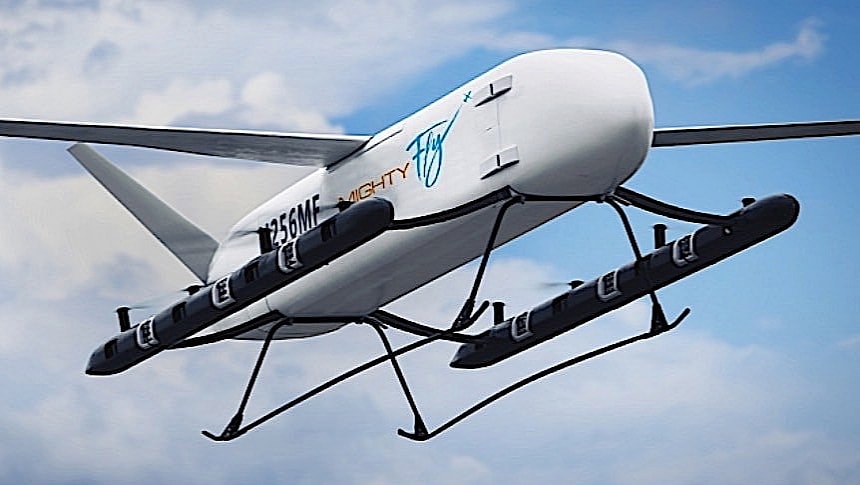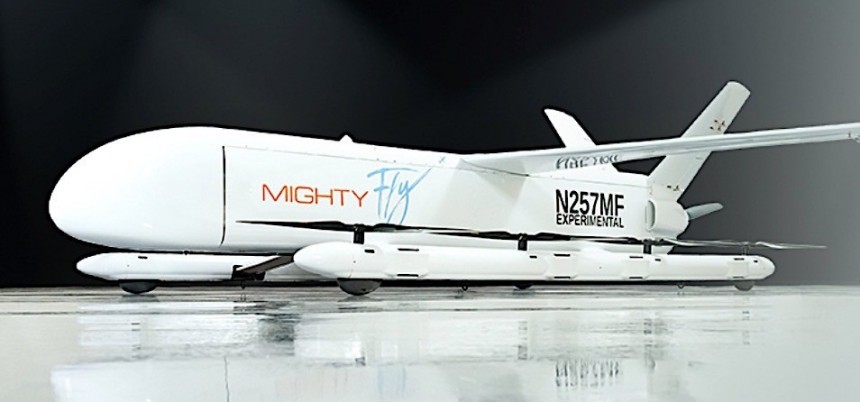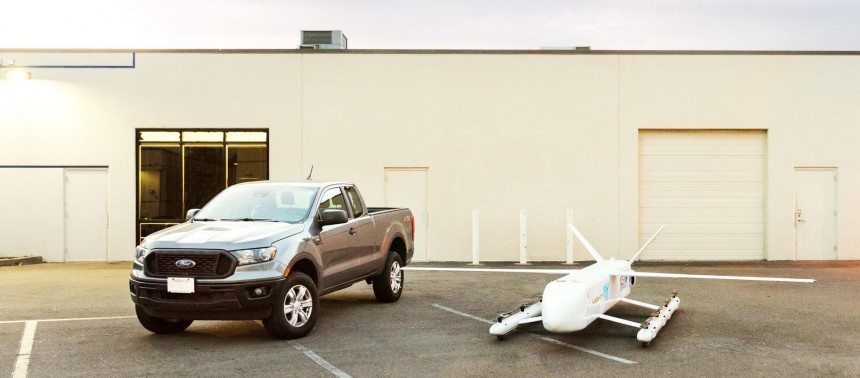Flight corridors are, if you will, roads in the sky. They're the invisible freeways aircraft follow to get from point A to point B while keeping safe and well away from other planes and helicopters. Flight corridors are mostly reserved for piloted aircraft, but that is changing now that drones are getting increasingly used. And the Federal Aviation Administration (FAA) just cleared the first large cargo drone to begin true flight testing.
The drone is called Cento, and it is made by a company called MightyFly. It's a company that was set up back in 2019 in San Francisco with the stated goal of creating a "better way to deliver goods" by using uncrewed aircraft.
That's something others are eyeing as well, including, say, Amazon, a company that is already experimenting with drone deliveries. But the Cento dwarfs the Amazon parcel delivery drones, as this one was not meant for parcel delivery from door to door, but for much greater (and heavier) things.
The Cento is an electric vertical take-off and landing aircraft (eVTOL). No less than eight vertical lift fans are there to get it airborne, and they join hands with a forward propulsion propeller to get the drone moving horizontally.
The thing can carry a total of 100 lbs (45 kg) of cargo, which is quite a lot by today's standards. That translates into anywhere between 96 and 212 small USPS packages, which can be delivered by the Centa to distances of as much as 600 miles (965 km).
It's autonomous, like many other drones currently being developed, but when it is fully ready for operations, it will be even more autonomous than what the competitors have to offer.
That's because Cento will not only be able to fly itself from point to point, but it will also have the ability to load and unload cargo without any direct help from humans. That's possible thanks to a new piece of technology called Autonomous Load Mastering System (ALMS).
What ALMS does is allow the Cento to open and close its cargo bay doors when needed. The drone can determine on its own the weight and balance of the cargo being loaded, and that should ensure it stays balanced in flight. MightyFly has not yet detailed how exactly the drone will arrange cargo to achieve this balance.
In the summer of last year MightyFly said it would soon begin test flights of the drone for demonstrative purposes in the state of Michigan. The scope of Cento's presence seems to have expanded, after the company announced a flight corridor approval received from the FAA for the state of California.
By all accounts , the Cento thus became the first autonomous drone of its size to get a flight corridor in the United States. As per the FAA papers, the Cento is as of now cleared to fly in the skies over Cali. The route links the New Jerusalem and Byron Airports of the Golden State, and rises to altitudes of at most 5,000 feet (1,524 meters).
MightyFly is cleared to operate the drone in Beyond Visual Line of Site (BVLOS) mode, but it does have to use a chase plane to make sure everything works as intended.
We're told that the drone tests at the corridor's origin airport started as far back as March 2024 and that 30 flights had already been completed there in just a few weeks. But the real work is only now about to begin, as the Cento will be put through its paces in point-to-point autonomous flights while using the same airspace other flying machines are using.
The drone's many systems will now be tested, including range, command and control systems, comms, and, of course, the detect and avoid technologies installed on board. Most importantly, the aircraft's capability of delivering goods, the reason for its existence, really, will be a major part of the upcoming test flights.
MightyFly says it will also begin demonstrations for potential customers, and that it will experiment with delivering "medical and pharmaceutical supplies, spare parts and manufacturing components, and fast-moving consumer goods."
Elsewhere, the Cento will also be demo-flown under contract with the Michigan Office of Future Mobility and Electrification, but also as part of a collab with the US Air Force (USAF). That is because the military branch, more specifically the Agility Prime and Air Mobility Command offshoots, are eyeing the Cento as a potential solution for its "most pressing autonomous aerial logistics needs."
Tests for USAF use were supposed to begin in February 2024, but we have no info on whether that actually happened. The USAF expects a demo of the drone's autonomous loading, unloading, and balancing of packages in early 2025.
Given its endless uses, and provided the testing stage goes as planned, chances are the Cento will become a common sight in the skies of the world. MightyFly does not provide us with info on when the Cento could become fully operational, or how much it will eventually cost.
That's something others are eyeing as well, including, say, Amazon, a company that is already experimenting with drone deliveries. But the Cento dwarfs the Amazon parcel delivery drones, as this one was not meant for parcel delivery from door to door, but for much greater (and heavier) things.
The Cento is an electric vertical take-off and landing aircraft (eVTOL). No less than eight vertical lift fans are there to get it airborne, and they join hands with a forward propulsion propeller to get the drone moving horizontally.
The thing can carry a total of 100 lbs (45 kg) of cargo, which is quite a lot by today's standards. That translates into anywhere between 96 and 212 small USPS packages, which can be delivered by the Centa to distances of as much as 600 miles (965 km).
It's autonomous, like many other drones currently being developed, but when it is fully ready for operations, it will be even more autonomous than what the competitors have to offer.
What ALMS does is allow the Cento to open and close its cargo bay doors when needed. The drone can determine on its own the weight and balance of the cargo being loaded, and that should ensure it stays balanced in flight. MightyFly has not yet detailed how exactly the drone will arrange cargo to achieve this balance.
In the summer of last year MightyFly said it would soon begin test flights of the drone for demonstrative purposes in the state of Michigan. The scope of Cento's presence seems to have expanded, after the company announced a flight corridor approval received from the FAA for the state of California.
By all accounts , the Cento thus became the first autonomous drone of its size to get a flight corridor in the United States. As per the FAA papers, the Cento is as of now cleared to fly in the skies over Cali. The route links the New Jerusalem and Byron Airports of the Golden State, and rises to altitudes of at most 5,000 feet (1,524 meters).
MightyFly is cleared to operate the drone in Beyond Visual Line of Site (BVLOS) mode, but it does have to use a chase plane to make sure everything works as intended.
The drone's many systems will now be tested, including range, command and control systems, comms, and, of course, the detect and avoid technologies installed on board. Most importantly, the aircraft's capability of delivering goods, the reason for its existence, really, will be a major part of the upcoming test flights.
MightyFly says it will also begin demonstrations for potential customers, and that it will experiment with delivering "medical and pharmaceutical supplies, spare parts and manufacturing components, and fast-moving consumer goods."
Elsewhere, the Cento will also be demo-flown under contract with the Michigan Office of Future Mobility and Electrification, but also as part of a collab with the US Air Force (USAF). That is because the military branch, more specifically the Agility Prime and Air Mobility Command offshoots, are eyeing the Cento as a potential solution for its "most pressing autonomous aerial logistics needs."
Tests for USAF use were supposed to begin in February 2024, but we have no info on whether that actually happened. The USAF expects a demo of the drone's autonomous loading, unloading, and balancing of packages in early 2025.
Given its endless uses, and provided the testing stage goes as planned, chances are the Cento will become a common sight in the skies of the world. MightyFly does not provide us with info on when the Cento could become fully operational, or how much it will eventually cost.























